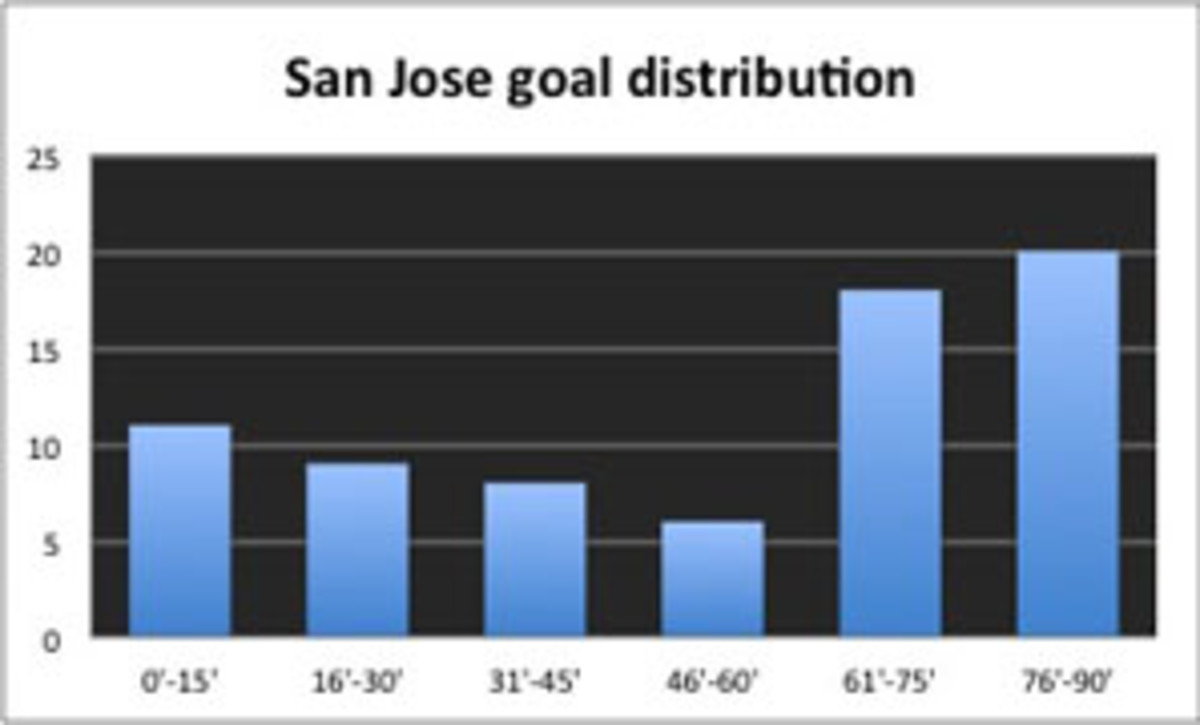Crunching numbers: Second chances in MLS' second season
Can the defending champs navigate the tricky waters a second time? Can the comeback kids keep defying the odds? Will the minnows announce themselves as the next league powerhouses? Now, those questions get answered.
1. Goonies say what?
I wasn't even alive in 1985, so I never saw "The Goonies" growing up. In an attempt to catch up with all the '80s movie references surrounding the San Jose Earthquakes this season, I finally sat down and watched it this weekend and decided to officially dub Buck Shaw Stadium the Goon Docks.
Despite San Jose's never-say-die attitude and its Supporters' Shield, there's still an air of skepticism that this group can bring the club back to the MLS Cup glory of 2001 and 2003. They've scored 20 goals in the last 15 minutes of games this season, and they can't keep pressing their luck.
But perhaps luck isn't as big a factor as everyone thinks. What stretches credulity even further than the Quakes' 20 late goals is that 18 of them have come in last-gasp wins or draws, and in eight out of the 11 such games San Jose has come from losing positions. Therein lies the key.
In most of San Jose's dramatic finishes, the opposition reached a point in the game when the priority switched from extending the lead to defending it, inviting more pressure from the trailing team. Nothing unusual there, except that when you give the Quakes' front line a chance, they're likely to finish it.
San Jose is the only team in the league to boast three forwards with 10 or more goals and a conversion rate of 15 percent or more (Chris Wondolowski with 27 goals and a 21.3 percent rate, Alan Gordon with 13 goals and a 30.2 percent rate and Steven Lenhart with 10 goals and a 15.6 percent rate). That's almost unfair. Most teams are lucky to have one striker in that form. New York is the only club with two.
They may have to wait late for their goals, but with numbers and chances like that, the Quakes will break through eventually. Frank Yallop has even been known to put Wondolowki, Gordon and Lenhart on the field at the same time. Talk about stacking the odds.
2. Leave the Wizards, take the Cauldron
There was reasonable uncertainty surrounding Kansas City's rebranding when it was announced in late 2010, but the growth of the club since has been undeniable. Who knew ditching the Dungeons & Dragons jokes (though they rightly kept the boiling supporters section known as "the Cauldron") could spark such a profound improvement? (A swanky new stadium and fresh players hasn't hurt, either.)
Fans not paying close attention could be forgiven for a sense of surprise at KC's ascension. Consistently bogged in mediocrity, Sporting Kansas City jumped to the top of the East in 2011 and finished in first again this season, with a five-point cushion above D.C. United.
While offensive production initially shot up from 35 goals in 2010 to 50 in 2011 -- the team's highest total in over a decade -- it dipped this season to 42, lower than six years ago when they finished second to last in the East.
Goals against Kansas City have gradually come down, dipping below the 45 goals conceded in 2006 and 2007 and never rising above it since. KC conceded 27 times this season, an all-time low.
It's at the intersection of these two roads that Sporting's progress really shines through. Since the club's decade-low goal difference of minus-9 at the end of the 2009 season, fans have been delighted to see their team's margin climb into positive territory for the first time since 2005. It settled at 15 this year, a 12-year high and an appropriate reflection of how far the club's come in a few years.
3. The second coming of Ben Olsen
Were it not for Sporting's rise from obscurity, D.C. United would be the comeback story of the season. It still may be, but whereas Kansas City's is the story of an organizational makeover, D.C.'s is focused on the transformation of one man.
Ben Olsen certainly didn't come out of nowhere, but his transition from player to manager has been a huge part of United's resurgence. Since finishing off Curt Onalfo's season in 2010, Olsen has led United to double its goal production, up to 42 in 2011 and 53 this season from just 21 in 2010.
That goal haul is, in part, due to players taking opportunities when they see them. D.C. United took 451 shots this season (13.3 shots per game),which was 100 more shots than in 2010 and up from the 11.2 shots per game they produced in 2010.
Even the loss of Dwayne De Rosario, who had a hand in 44 percent of United's total offense before his injury, hasn't slowed them down. In fact, they've gone undefeated in their last seven games and put together a league-best 5-0-2 record to close out the season.
Club president Kevin Payne has suggested the strong finish is due to defensive solidarity in the wake of losing one of the team's star players. The club's average goals against per game plummeted after De Rosario's injury, from 1.6 to 0.7, while blocked shots per game rose from 3.1 to 4.9. D.C. fans will look forward to DeRosario's possible return during the playoffs, but even if they don't see another DeRo dance until next season, the Screaming Eagles and Barra Brava may still have something to cheer for at long last.





